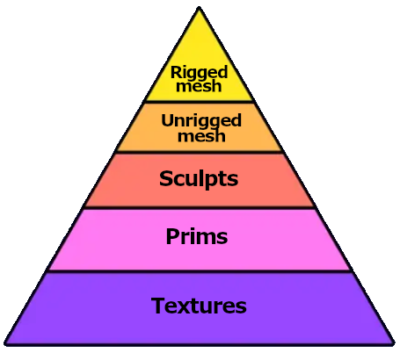[This article was written in 2014, but has received minor updates to make it relevant for 2024]
Whilst shopping lately, I’m increasingly seeing what seems to be the same dresses being sold at various different shops. This is not reselling, but a case of designers buying in meshes from third parties (what I refer to as “Merchant Mesh” or “Non-Original Mesh” or “Reseller Mesh”).
This is not a new phenomenon, of course. In the past designers often bought full permission sculpts for use in their products, but it was less noticeable as using a sculpt here and a sculpt there is more finely grained; it still creates an overall unique product. In other words, two outfits using the same sculpts might look radically different, because you don’t notice the common sculpts so much, or the designers may be using them in different ways, with different placements, sizing, and the like. They may even be using different permutations of several sculpts from different creators. The overall look is therefore completely different, and the end result unique to that brand. By contrast, a mesh for a dress is entirely monolithic which gives rise to the situation where several clothing brands appear to be selling the same dress.

Clothing has gone through quite an evolution over the life of Second Life. From the original “slider clothing” (a.k.a. “system clothing”) with or without user-created textures, through to texture + prim, texture + flexiprim, texture + sculpts, texture + unrigged mesh, and rigged mesh (with standard sizing).
[Update: and now fitmesh (for mesh bodies)]
At each step in this evolution, the bar for entry to the next level has been raised. Also, from sculpts onwards, they require external software for creation which has its own (often steep) learning curve.
Often, a designer may find they have insufficient skill (and/or time, motivation, commitment or, indeed, ability) to move up to the next level, and can sometimes buy in the 3D models (ie. sculpts or mesh) and texture them into full products. The reason is that in some cases others may have the skill to create the 3D models but not the inclination to make them into products and have the hassle of selling to Residents. In some ways this is roughly analogous to Retailers and Wholesalers in Real Life.
As each tier of the pyramid gets harder and harder to reach, so the number of people reaching it falls, and so the probability of those people selling their creations to designers lower down the pyramid rises (since there is an increasing demand). Or, to put it another way, there is a very small pool of people creating rigged meshes, and from that pool some are keeping them unique to their clothing brand, and others are selling them for other designers to use. And that is why we are seeing many brands selling the same clothes (or appearing to), since not only is their choice more limited but the very nature of rigged mesh means the clothing is more obviously the same (as I mentioned earlier on).
The net effect of the above is that we are seeing a stratification of the clothing market in Second Life, with the “top tier” of brands being created by very talented people who can create 3D models (ie. mesh clothing), rig it to become rigged mesh, skilfully texture it, and then sell it to ordinary people like you or I. The “second tier” are the designers who are unable to create their own rigged meshes and must buy them in, thus running the very real risk that some of their clothes will be extremely similar, if not identical, to those of other brands.
Further on down the pyramid, the hobbyists of old who would dabble with prims in-world and with simple textures created with the aid of clothing templates, are increasingly finding that their efforts look unsatisfactory compared to the top designers. They are either having to make their clothing very cheap to compensate, and find themselves unable to afford the rent on their shops, or else are giving up, disheartened. Neither scenario can be good for the long-term health of Second Life.
[Update: Obviously this is less true now that we have BoM – see the note at the end]
Nor is this situation looking likely to improve. As mentioned in my previous blog entry, Linden Lab have decided to go down the path of using collision bones for their Fitted Mesh project. Whilst this is a technically simpler and, some may say, more elegant solution to mesh clothing deformation, it makes the task of rigging mesh even harder for content creators, thus making that top tier of the pyramid even harder to reach.
I’m not sure where this state of affairs will take Second Life, but I do believe that warning alarms should be ringing somewhere. By making content harder and harder to create, so less and less is going to be created. Not only that, but people who may have found Engagement in Second Life through content creation might decide it is not worth it and instead drift away. However, having said that, I do acknowledge that we need to move forward and people are expecting ever more complex and realistic-looking technologies which, by their nature, are harder and more complex to create. But that doesn’t necessarily negate my point.
So, anyway, those are my thoughts on this. They’re only my opinion, so please feel free to comment below with yours.
Update
Obviously a lot has changed since I wrote this, and we now have Bakes on Mesh (BoM). I have a more recent article on the subject here, and in it I discuss how BoM has opened up the market again to allow bottom tier designers to work in just textures again.

